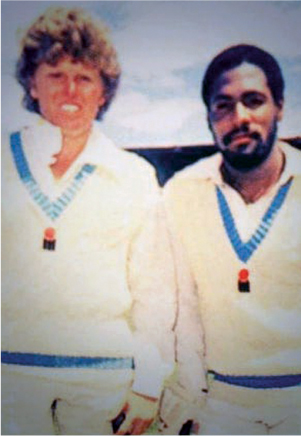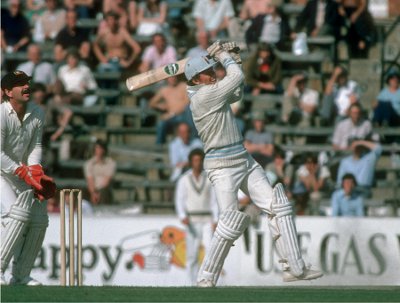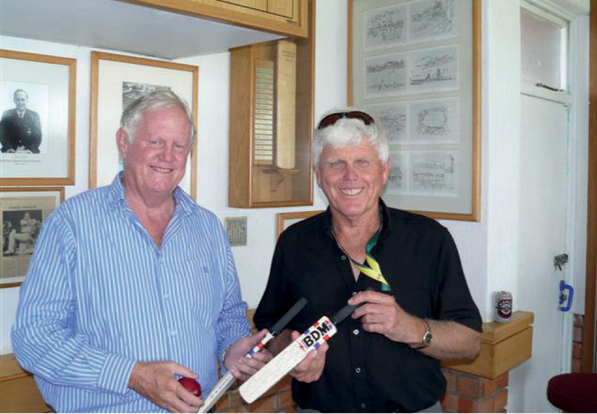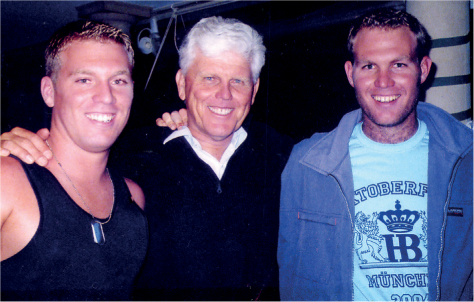

The young Barry Richards. I am not alone in thinking that the toothy schoolboy with the mop of curly hair resembles a putative US president – John Kennedy.
(BAR personal collection)

Barry Richards on the sweep for Hampshire against Middlesex at Lord’s in 1968. John Murray is the wicketkeeper and Peter Parfitt is at slip. Barry’s unusually high grip on the bat handle can be clearly seen here. “Bats were much thinner then and not so springy,” he explained, “so I needed a longer pendulum to get some leverage on the ball.” He promised he would score 2,000 runs in this, his first season in English cricket. And he did.

Natal Schools 1962. Three future Test cricketers here. Mike Procter is on the far right, top row. Barry is seated, second from left. On his left is the captain, Lee Irvine. In fact, most of this team went on to play first-class cricket. “It was a helluva side,” said Irvine. Do regard Barry’s immaculately creased flannels and his sparklingly white boots. Grandpa Percy would have nodded his head in approval. (Lee Irvine personal collection)

The South African XI at Kingsmead, Durban for the second Test against Australia in 1970. Top l-r: Mike Procter, Dennis Gamsy, Barry Richards, John Traicos, Lee Irvine, Pat Trimborn. Seated l-r: Tiger Lance, Graeme Pollock, Eddie Barlow, Bob Williams (manager), Ali Bacher (capt), Trevor Goddard, Peter Pollock. This was the scene of Barry’s maiden Test hundred. Perhaps the description of him as the golden boy of South African cricket was not that far wrong – just look at the bright halo illuminating his hair! (John Traicos personal collection)

Barry square cuts during his innings of 140 v Australia at Kingsmead, Durban in 1970. The Springbok emblem is clearly visible on his cap. Where is it now? Sadly, Barry has no idea.
(BAR personal collection)

The sorcerer and his apprentice. Barry Richards and Graeme Pollock in discussion after their famous partnership of 103 in 60 minutes’ play after lunch on the first day of the second Test against Australia at Kingsmead in 1970. It was immediately dubbed The Golden Hour by the press and has gone down in South African folklore. Barry scored 140; Pollock went on to score 274. “I don’t think this country has ever again seen batting like we saw that day,” said Ali Bacher, their captain.
(George Byron personal collection)

The Australian captain, Bill Lawry, congratulates Barry on completing his century at Kingsmead. Barry had been denied reaching his hundred before lunch on the first day of the second Test by some outrageous time wasting by Lawry, who seemed to be inordinately concerned by the state of his bootlaces. No matter. Three figures were reached shortly after the break. (George Byron personal collection)

Barry Richards – The Man with a Golden Future. The year is 1970 and Sports Illustrated could be forgiven for their enthusiastic headline. In fact, Barry’s golden future in Test cricket had just one month to run. (George Byron personal collection)

Barry hooks Alan Connolly of Australia during his innings of 126 at Port Elizabeth in the fourth Test of the 1970 series. It was to be his final innings in Test cricket. He had played four matches and scored 508 runs at an average of 72.57. “The bona fide great who never was,” Telford Vice poignantly observed.

Barry batting for The Rest of the World v England at Lord’s in June 1970. “I played all right,” said Barry of his performances during the five match series, “but I never hit the heights.” Surprisingly true during this year of all years, his annus mirabilis. That said, do admire the balletic poise and perfect balance as he hits the ball, perched on tiptoe, away on the off side.

Barry plays a classical, lofted on drive, a shot of majesty, power and elegance, for Hampshire against Glamorgan at Northlands Road, Southampton, in 1970. “That went for six,” he informed me. (Patrick Eagar)

Hampshire v Northamptonshire at Northlands Road in August 1973. This was taken during Barry’s unforgettable tussle with Bishan Bedi, the world’s premier batsman taking on the world’s best slow left-armer. Whoever won the duel won the match. And whoever won the match won the championship. The stakes were that high. This drive off the back foot is straight out of the text-book, with the top hand in control, the left elbow high, the head perfectly aligned, heels off the ground to stand tall and the bottom hand following through to add power. The technique had been perfected after endless hours in the nets as a young boy. (Patrick Eagar)

Hampshire County Champions 1973. Taken at their home ground at Northlands Road, Southampton. Top l-r: Richard Lewis, David O’Sullivan, Mike Taylor, Tom Mottram, Bob Herman, Gordon Greenidge, the author, Trevor Jesty. Seated l-r: David Turner, Peter Sainsbury, Richard Gilliat (capt), Barry Richards, Bob Stephenson. (Patrick Eagar)

Gordon Greenidge and Barry Richards open the batting for Hampshire at Northlands Road in 1973. Has there ever been a better opening partnership in the history of county cricket? (Patrick Eagar)

Barry clips the ball away on the leg side batting for Natal against Eastern Province in the Currie Cup at St George’s Park in Port Elizabeth, March 1974. He scored 106 but bad weather prevented Natal from winning the match. However they secured sufficient bonus points to allow them to claim the Currie Cup that season. Note the flimsy protective equipment worn in those days: the lightweight pads, thin thigh pad on one leg, insubstantial gloves, no arm guard, no chest protector….and no helmet! Not that he would have needed one when I bowled to him. (George Byron personal collection)

A faultless stroke by Barry during his innings of 189 at a deserted Lord’s in April 1974. We all thought that he had put on a bit of weight over the winter. In fact, he had donned every sweater that he could lay his hands on, it was that cold. It didn’t stop him however from putting a strong MCC attack to the sword. This innings prompted the famous analogy drawn by Tony Lewis, in which he compared Barry to Yehudi Menuhin reeling off a perfect piece of Bach in front of an empty Albert Hall. In my eyes, it was simply the greatest exhibition of batsmanship I have ever witnessed. (Patrick Eagar)

Hampshire v Lancashire in the Gillette Cup at Bournemouth in August 1972. In many ways, this can be regarded as the most famous photo of Barry at the crease. He scored 129 that day and displayed the genius – and there is no other word for it – for which his batting was becoming renowned. The Lancashire spinners, Jack Simmonds and David Hughes, were firing the ball down the leg side, protected by a packed leg side field. The Lancashire spinners were firing the ball down the leg side – look how far across to leg the wicket keeper, Farokh Engineer, has gone – protected by a packed leg side field. Yet Barry has stepped away to leg and played a cover drive! (Patrick Eagar)

Currie Cup action. Natal v Transvaal. Barry is batting, Lee Irvine is behind the stumps and Donald Mackay-Coghill is fielding (rather deep!) at backward short leg. Barry here looks a little cramped as he plays the shot but he is still in control and on top of the ball. His head remains balanced and he has rolled his wrists at the moment of impact to keep the ball down. Incidentally, I never thought the beard suited him. (Lee Irvine personal collection)

Old friends reunited. Barry meets up with Greg Chappell before the start of the Hampshire v Australia match in 1975. The warmth of their handshake bore testimony to the regard in which each held the other. It is a friendship that remains close to this day. (Patrick Eagar)

Hampshire v Australia at Northlands Road in 1975. Barry relished the opportunity of playing against the tourists, many of whom were his friends. He certainly relished this powerful stroke off the back foot during his innings of 96. Max Walker is at short leg. (The ball’s over there, Max!) (Patrick Eagar)

There is so much to admire in this photo of Patrick Eagar’s. The light is perfect, the late afternoon sun at Northlands Road casting an almost ethereal glow on Barry’s sweater and the stumps. The stroke too is a thing of beauty – balanced, elegant, orthodox and perfectly timed. And the face is a picture of fierce concentration. Perfection takes hard work. (Patrick Eagar)

Hampshire v Middlesex in the Sunday League at Lord’s in June 1977. Ian Gould is the wicketkeeper. Barry scored 102 out of his side’s total of 178. It was another of those masterful innings that we all crowded onto the small dressing room balcony to watch. John Emburey was the luckless bowler, I believe.
(Patrick Eagar)

Mike Procter and Barry Richards, schoolboy friends, in opposition. It was a Benson and Hedges semi-final in 1977 at Northlands Road between Hampshire and Gloucestershire. Yes, that match! Procter won it for Gloucestershire practically single-handed, taking 6-13, including a game changing hat-trick. I was not one of his hat-trick victims, though perhaps I should have been. I was otherwise engaged in the lavatory. And we never did get to a Lord’s final. (Patrick Eagar)

Don Bradman’s Dream Team (digitally created). Top l-r: Ray Lindwall, Barry Richards, Dennis Lillee, Bill O’Reilly, Don Tallon. Seated l-r: Clarrie Grimmett, Alec Bedser, Sachin Tendulkar, Don Bradman (capt), Garry Sobers, Arthur Morris, Wally Hammond. Bradman described Barry as “the world’s greatest ever right-handed opener.” When the South African tour to Australia in 1971 was finally called off and South Africa’s isolation from international competition was confirmed for another 22 years, Bradman said that it was the saddest day of his life because “it meant the end of Barry Richards’ Test career.”

Nobody ever claimed that the 1970s was a halcyon era of fashion. For all that, this delightfully informal shot of Barry shows him in a rare relaxed mood in the midst of the hectic schedule of a professional cricketer, one with which he became increasingly disenchanted. (George Byron personal collection)

The two Richards, Barry and Viv. Who was the greater batsman? The jury’s still out on that one. Here they are in the same team for once, the World XI in Kerry Packer’s World Series Cricket. Barry looks as if he has had some attention given to his finger by those West Indian fast bowlers in the nets.
(BAR personal collection)

World Series Cricket. WSC World XI v WSC Australia in Perth 1978. Barry scored 208. Here is one of four sixes he hit that day in an exhibition of strokeplay that left everyone, including wicketkeeper Rodney Marsh, open mouthed in admiration. WSC had given Barry a belated chance in his career to test himself in the international arena again. But by now, he was 34, not 24. “My eyes had gone,” he later admitted, “so it wasn’t the carefree approach of days gone by. I had to fashion my innings.” He wanted to prove to himself, not the rest of the world, that he could still do it. And he did, with skill, courage and determination. He topped the averages in Supertests of all the teams. “Believe it or not,” he told me, “if they had counted those Supertests as Test matches, I would have played enough matches to be included in the official list and my average would have gone up from 72 to 79!” Second only to the incomparable Bradman. Is there any more that needs to be said? (Patrick Eagar)

The two legends of South African cricket, Graeme Pollock and Barry Richards, in The Kingsmead Mynahs Room inside the stadium in Durban. I expect both could have made runs with those miniature bats too.

Barry as TV commentator. The occasion is the ICC World Cup in April 2007, South Africa v England at Bridgetown, Barbados. Graeme Smith, the SA captain, is tossing the coin and his England opposite number, Michael Vaughan, clearly trusts him because he is not watching. Probably, he realises that the match referee, Ranjan Madugalle, will ensure that no monkey business takes place. (Getty)

Happier times. Barry is flanked by his two sons, Mark on the left and Steve on the right. Mark’s suicide in 2009 devastated the family. Barry remains deeply affected. “You just don’t get over something like that,” he told me. “The nightmares have diminished but I still get sleepless nights.” (BAR personal collection)

Gary Player introduces Barry to Nelson Mandela on the occasion of the Gary Player Golf Tournament to raise money for Mandela’s children’s charity. Like all South Africans, and indeed most people on the planet, Barry greatly admired his nation’s father figure.
(BAR personal collection)

Barry with his partner Ingrid Diesel. “You know, Murt,” he said to me, “I’ve always punched above my weight with women.” This delightful photo seems to underline that very fact. Barry reckons Ingrid saved him “from a very dark place” following the death of his son. For that, and her many other qualities, he remains deeply grateful. (BAR personal collection)